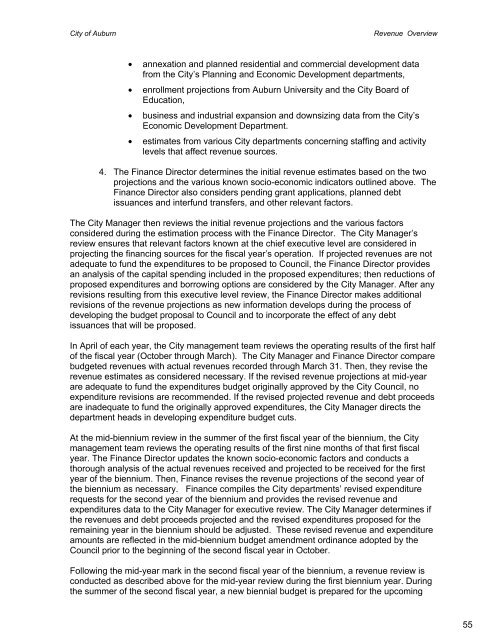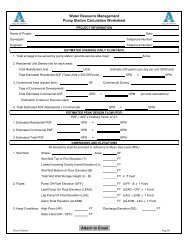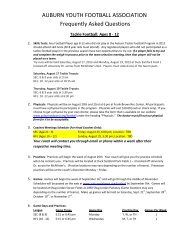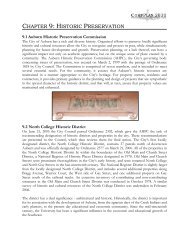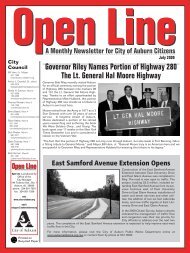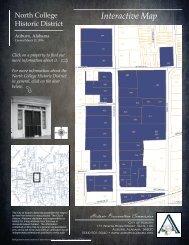Complete Document - City of Auburn
Complete Document - City of Auburn
Complete Document - City of Auburn
You also want an ePaper? Increase the reach of your titles
YUMPU automatically turns print PDFs into web optimized ePapers that Google loves.
<strong>City</strong> <strong>of</strong> <strong>Auburn</strong>Revenue Overview• annexation and planned residential and commercial development datafrom the <strong>City</strong>’s Planning and Economic Development departments,• enrollment projections from <strong>Auburn</strong> University and the <strong>City</strong> Board <strong>of</strong>Education,• business and industrial expansion and downsizing data from the <strong>City</strong>’sEconomic Development Department.• estimates from various <strong>City</strong> departments concerning staffing and activitylevels that affect revenue sources.4. The Finance Director determines the initial revenue estimates based on the twoprojections and the various known socio-economic indicators outlined above. TheFinance Director also considers pending grant applications, planned debtissuances and interfund transfers, and other relevant factors.The <strong>City</strong> Manager then reviews the initial revenue projections and the various factorsconsidered during the estimation process with the Finance Director. The <strong>City</strong> Manager’sreview ensures that relevant factors known at the chief executive level are considered inprojecting the financing sources for the fiscal year’s operation. If projected revenues are notadequate to fund the expenditures to be proposed to Council, the Finance Director providesan analysis <strong>of</strong> the capital spending included in the proposed expenditures; then reductions <strong>of</strong>proposed expenditures and borrowing options are considered by the <strong>City</strong> Manager. After anyrevisions resulting from this executive level review, the Finance Director makes additionalrevisions <strong>of</strong> the revenue projections as new information develops during the process <strong>of</strong>developing the budget proposal to Council and to incorporate the effect <strong>of</strong> any debtissuances that will be proposed.In April <strong>of</strong> each year, the <strong>City</strong> management team reviews the operating results <strong>of</strong> the first half<strong>of</strong> the fiscal year (October through March). The <strong>City</strong> Manager and Finance Director comparebudgeted revenues with actual revenues recorded through March 31. Then, they revise therevenue estimates as considered necessary. If the revised revenue projections at mid-yearare adequate to fund the expenditures budget originally approved by the <strong>City</strong> Council, noexpenditure revisions are recommended. If the revised projected revenue and debt proceedsare inadequate to fund the originally approved expenditures, the <strong>City</strong> Manager directs thedepartment heads in developing expenditure budget cuts.At the mid-biennium review in the summer <strong>of</strong> the first fiscal year <strong>of</strong> the biennium, the <strong>City</strong>management team reviews the operating results <strong>of</strong> the first nine months <strong>of</strong> that first fiscalyear. The Finance Director updates the known socio-economic factors and conducts athorough analysis <strong>of</strong> the actual revenues received and projected to be received for the firstyear <strong>of</strong> the biennium. Then, Finance revises the revenue projections <strong>of</strong> the second year <strong>of</strong>the biennium as necessary. Finance compiles the <strong>City</strong> departments’ revised expenditurerequests for the second year <strong>of</strong> the biennium and provides the revised revenue andexpenditures data to the <strong>City</strong> Manager for executive review. The <strong>City</strong> Manager determines ifthe revenues and debt proceeds projected and the revised expenditures proposed for theremaining year in the biennium should be adjusted. These revised revenue and expenditureamounts are reflected in the mid-biennium budget amendment ordinance adopted by theCouncil prior to the beginning <strong>of</strong> the second fiscal year in October.Following the mid-year mark in the second fiscal year <strong>of</strong> the biennium, a revenue review isconducted as described above for the mid-year review during the first biennium year. Duringthe summer <strong>of</strong> the second fiscal year, a new biennial budget is prepared for the upcoming55


